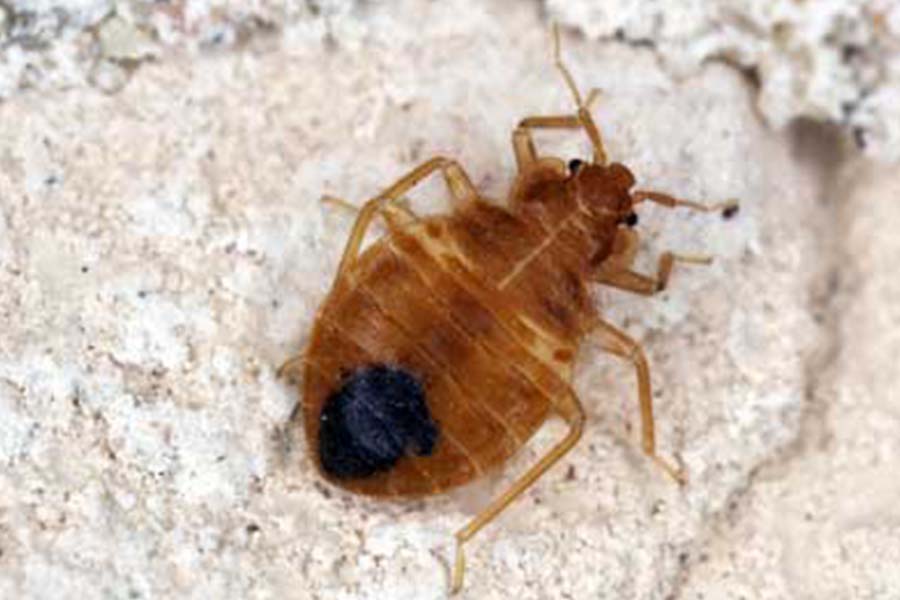
Bed bugs are often described as looking like tiny, flat apple seeds with a reddish-brown hue. They have six legs, two antennae perched on top of their heads, and their bodies are divided into three segments. When they’ve just fed, their flat bodies swell and appear more engorged. Here are some key features to look for:
- Reddish-brown color
- Flat bodies that can puff up after feeding
- Adult bed bugs are about 5 mm long
- Their eggs are small, white, oblong, and roughly 1 mm in length
How Big Are Bed Bugs?
On average, adult bed bugs are around ¼ to 3/16 of an inch long, which is about the size of an apple seed. Their size can change a bit depending on whether they’ve recently had a meal. After feeding, they stretch out, becoming slightly longer and more cylindrical. Despite being sneaky and good at hiding, adult bed bugs are still visible to the human eye, which can be reassuring when trying to spot them.
Click the button below to leave your information & we'll be in touch in an hour or less.Do You Have a Bed Bug Problem? We Can Help.
Common Insects That Look Like Bed Bugs
It’s easy to panic at the sight of any tiny, crawling creature in your home, immediately thinking of bed bugs. But before you jump to conclusions, it’s good to know that several other insects look a lot like bed bugs:
- Fleas: Fleas share a similar small, reddish-brown appearance with bed bugs but are usually a bit longer, flatter, and smaller. Flea bites usually show up as random clusters across your body and are noticeable pretty quickly, unlike bed bug bites, which often form in lines or zigzag patterns and might not appear for days.
- Ticks: These little guys have flat, wingless bodies, which can make them seem similar to bed bugs at first glance. They also feed on human blood, leaving behind itchy bites. However, ticks have eight legs, while bed bugs only have six. Plus, ticks tend to latch onto their hosts for hours or even days, unlike bed bugs, which are more likely to hang out on your bed, furniture, or clothes.
- Carpet Beetles: At first glance, carpet beetles may seem similar in shape to bed bugs, but they come in a variety of colors and have much shorter antennae. Their larvae look fuzzy, more like tiny caterpillars, and although they don’t bite humans, their larvae’s hairs can cause skin irritation, sometimes mistaken for bed bug bites. Carpet beetles are usually found in carpets or upholstery, feeding on natural fibers like wool.
- Booklice: Booklice have longer bodies, bigger heads, and bent antennae, setting them apart from bed bugs. They’re also typically found in damp places, where they munch on mildew and mold instead of feasting on blood.
How to Tell if You Have Bed Bugs or Carpet Beetles
Bed bugs and carpet beetles can be tricky to tell apart because they’re both small, oval-shaped, and tend to hide out in similar places. To tell the two insects apart, look at these details:
- Color: Carpet beetles come in a range of colors, while bed bugs stick to a reddish-brown shade.
- Antennae: Carpet beetles have short antennae, while bed bugs have more visible antennae on their heads.
- Size: Carpet beetles are typically smaller than bed bugs, which are about the size and shape of an apple seed.
- Eyes: You can spot bed bug eyes up close, but it’s a lot more challenging to see the eyes on carpet beetles.
- Larvae: Bed bugs do not go through a larva stage after hatching from their eggs, while carpet beetle larvae are fuzzy and look more like tiny caterpillars.
Bed Bug Life Cycle
The life of a bed bug starts with a tiny egg, and then the bug passes through five nymph stages before reaching adulthood. Bed bugs lay their eggs in places like mattresses, furniture, wall cracks, baseboards, and floorboards. These eggs are tiny, white, and oblong, only about 1 mm long.
As the bed bug nymphs grow, they look like smaller versions of the adults. After each blood meal, a nymph sheds its exoskeleton, growing a bit bigger each time until it finally becomes a fully mature bed bug.
Back to Bed Bug Identification